When you walk into a dark room, what do you do? If you’re like most people, you reach for a light switch. But depending on how a room is laid out, there might not be a switch exactly where you need it. This could simply be a case of poor design. But there are many other reasons you might need another way to control your outlet.
For one thing, you might live in a very old house. If your house is old enough, the electrical wiring may have been added well after the original construction. In that case, the owners may have installed a minimal number of switches in order to save money. Brick and stone walls also make it challenging to install new switches.
In any of these cases, a remote-controlled electrical outlet can be an excellent solution. With these outlets, you simply press a button on the remote, and the outlet turns on and off. It’s a great way to control a lamp, or anything else you want to control via a switch. These can come in many forms. You might have a handheld fob, or a wireless switch you can mount on your wall.
Different outlets also have their own quirks. For example, some can offer more or less wattage than others. As a result, you don’t want to buy just any remote-controlled outlet. You want one with the right features to meet your needs.
Choosing the Best Wireless Remote Control Electrical Outlet
Before we go any further, let’s talk about the fundamentals. Why would you want to choose one indoor wireless remote as opposed to another? There are any number of things you might be looking for. But essentially, they fall into four categories: the number of sockets, the wattage, the remote range, and the controller functions. Here’s a quick primer on all of the basics.
Number of Sockets
The first question you should ask yourself is how many outlets are you going to need. If you’re only trying to add one device, like a floor lamp, then a single outlet will do. But especially if you’ve got an older house, you might want to add multiple remote-controlled outlets. Many companies offer kits with three or even more outlets, so you can add several to your home at once. Typically, this will be more affordable than buying multiple single remote-controlled outlets.
Wattage
Another important consideration is the total wattage. A standard North American wall outlet provides 110 volts of power at 15 amps. That’s 1,650 watts of total power. That said, not all remote-controlled outlets have this much capacity. Whether or not this is a problem depends on your application. Typically, people use these outlets for lights, and any wattage will be fine for that application. That said, if you’re running something like a space heater, you’re going to want to read the fine print.
Remote Range
Depending on your needs, you may need a remote with longer or shorter range. The shortest-range remotes are infrared remotes, which work within the same room. However, there’s a good reason most manufacturers are no longer using IR remotes. Because of the nature of infrared waves, these remotes work via line-of-sight only. If your outlet is behind a sofa or under an end table, that’s not going to be very convenient.
A better alternative is to use an RF remote. RF signals don’t rely on line of sight, and can reach as far as 50 or even 100 feet. Different remotes will have a different range, depending on the quality of the transmitter and receiver. Keep in mind that just because they don’t rely on line of sight doesn’t mean obstructions are irrelevant. If there’s a thick stone wall between you and the receiver, that will significantly reduce the range. Similarly, RF signals are subject to interference from things like RC cars.
We should note that there are some WiFi-controlled outlets that can be switched on from anywhere in the world. You’d rarely, if ever, need this for any indoor applications. But it’s a common feature with many outdoor remote-controlled outlets.
Controller Functions
On a more basic level, look at the form and function of the remote. To begin with, how is it designed? Is it a key fob? A full-sized remote control? A wall-mounted switch? All of these have their benefits and drawbacks. A full-sized remote, for example, is inconvenient to carry around. But it’s easier to locate if you have it sitting on a shelf or table. Conversely, a key fob is easier to lose, unless it’s attached to your keys.
Along the same lines, if you have a multi-outlet kit, are there multiple sets of on/off buttons? Or are you controlling all the outlets simultaneously? If the outlets are in different rooms, you’ll definitely want a remote with separate controls.
Best Overall: BN-LINK Wireless Electrical Outlet
BN-LINK knows a thing or two about power outlets and accessories. For example, we’ve reviewed their surge protector timer, which is straightforward and easy to use. Because if their reputation for quality, we had a good feeling about reviewing their wireless remote.
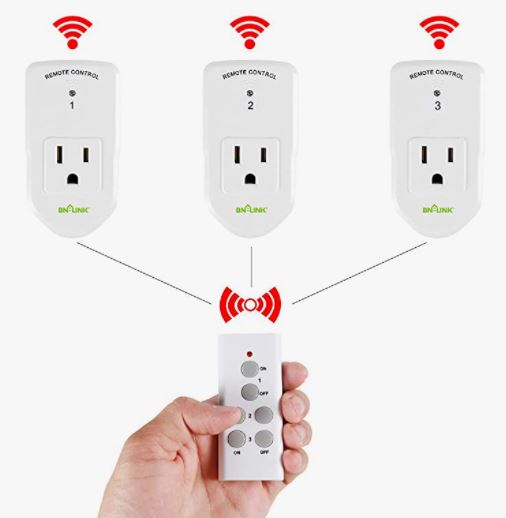
The BN-LINK Wireless Remote Control Electrical Outlet isn’t just a single outlet. It’s a kit consisting of three single-socket outlets, and a single handheld wireless remote. The outlets themselves are made from a white ABS plastic, with an unassuming matte finish. They’re roughly rectangular in shape, with a little curved protrusion at the bottom with a green BN-LINK imprint. The three-prong socket itself is located just above this imprint, and is polarized for safety. Above the plug, there’s a larger blank area, with an indicator light. In this same area, there are also the words “Remote controller,” along with a “1,” “2,” or “3.” Be aware that this receiver is fairly large. If you plug it into the bottom of a duplex outlet, it’s going to block the top. Make sure to plug it into the top outlet, so you don’t run into this issue.
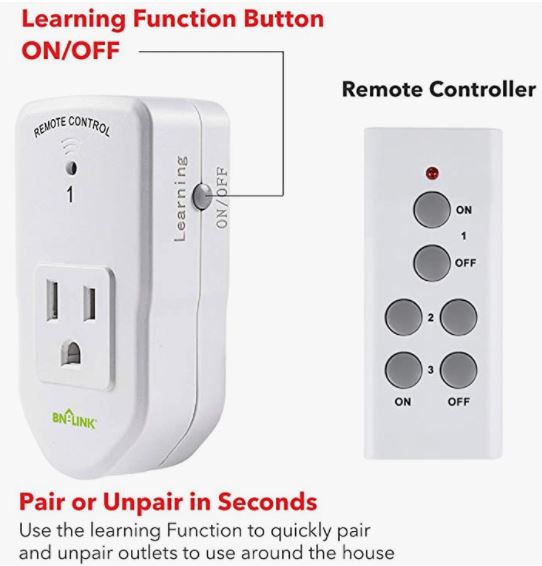
The numbers on the outlets correspond to the numbers on the handheld controller. This controller is smaller than a smartphone, and has three sets of rubber on/off buttons. These sets of buttons are numbered, and they work with the corresponding outlets right out of the box. That said, they can also be reprogrammed. This allows you to create custom control groups. For example, let’s say you have two lamps in your living room, and you want to control them together. In that case, you could map both outlets to the same set of buttons, and operate them with one press.
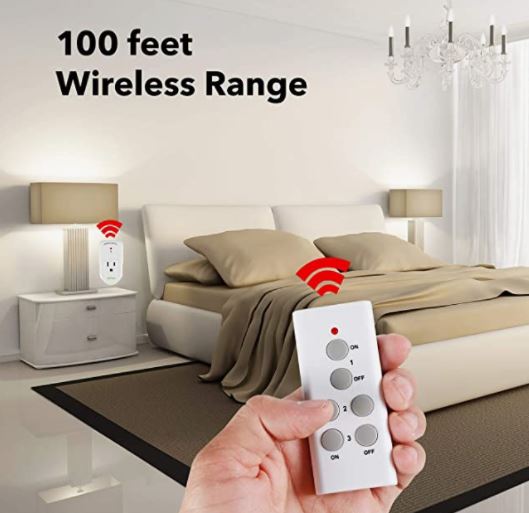
The remote comes with its own battery, and uses an RF signal. As we discussed, an RF signal can penetrate most physical obstacles. So if you’re in the next room, you’ll still be able to control your outlet. In terms of signal strength, you get a maximum range of 100 feet, assuming a clear line of sight. That’s good enough to penetrate through even a stone wall, although your range will be reduced in that case.
One feature we appreciated is that the outlets will stay off when power returns after an outage. This reduces your risk of damaging your electronics or causing a fire. On the downside, each outlet only provides a maximum of 1,200 watts of power. That’s plenty for most applications, but steer clear if you need to run a high-wattage device.
Best Runner-Up: Fosmon Wireless Electrical Outlet/Switch
The Fosmon Wireless Remote Control Electrical Outlet Switch consists of a single outlet and a wall-mounted switch. Both are made from a matte white plastic, which fits most décor schemes. The outlet portion is rectangular and blocky, and won’t block the other half of a duplex outlet. There’s a polarized three-prong outlet in the front center, with an indicator light at the top right.
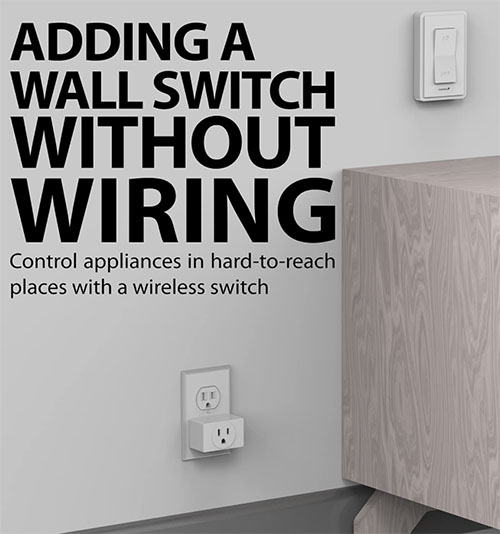
The control unit is a toggle switch, with braille markings at the on and off positions. There’s a tiny LED in the middle of the rocker switch to let you know when the outlet is on. This toggle switch is designed to be wall-mounted, and comes with an easy-to-install wall mounting plate. It sticks out further than a normal wall outlet, but it’s not as thick as you might think. Instead of a larger battery, it uses a slim CR2032 battery to keep things compact. That said, there’s no reason you have to wall-mount the switch. The back is mostly flat, so it can still be used as a handheld remote.
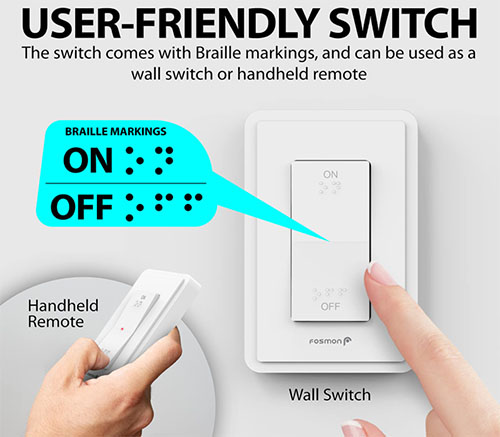
The Fosmon switch has an 80-foot range, and a line of sight is not required for its RF signal to work. As an added benefit, you can order more switches or more outlets as needed. One switch can be paired with multiple outlets, or vice-versa. Not only that, but this switch is also compatible with their other outlets, switches, and outdoor outlets. Everything in the package is covered by a limited lifetime warranty. If there are any defects, you’ll be fully protected.
Best Alternative: DEWENWILS Indoor Remote Control Outlet
DEWENWILS is another manufacturer we’ve reviewed before. Their foot switch extension cord impressed us with its low-profile design and nifty indicator lights. The DEWENWILS Indoor Remote Control Outlet is similarly well-designed. It consists of one power outlet, along with a small remote fob that you can carry on your keychain.
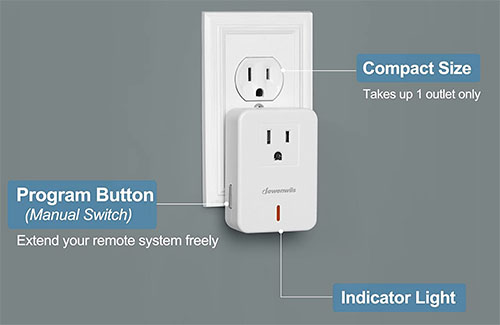
The outlet has a matte white housing, with a rectangular design. The three-pronged polarized outlet is located at the top of the front. Underneath, there’s a red indicator life, with a grey DEWENWILS stamp above it. This lower portion will block the bottom of a duplex outlet if you plug it into the top socket. If you plug it into the bottom outlet, this won’t be a problem. On the downside, the maximum wattage is only 1200 watts. But unless you need to run a high-powered appliance, this won’t be an issue.

The handheld controller is simple and straightforward. It’s about the size of a car door remote, with grey rubber on and off buttons. At the back edge, there’s a short metal chain, which connects to a key ring. As a result, it’s easy to carry around with you on an everyday basis. Despite the small size, the RF signal is surprisingly strong. With a clear line of sight, it has a range of over 100 feet. Even in a cluttered house, you won’t have trouble getting a signal.
Which is the Best Remote Control Electrical Outlet?
All three of these wireless remote control electrical outlets are well-designed. But which one is the right choice for you? We began with the BN-LINK Wireless Remote Control Electrical Outlet. The most obvious advantage of this kit is that it comes with three outlets instead of one. But we also liked the customizable control, with the ability to set up groups. Unless you need to run a high-wattage device like a space heater, this is a great choice.
The Fosmon Wireless Remote Control Electrical Outlet/Switch is a great choice if you need a wall switch. It’s not ideal if you want a portable switch, but it also works well as a traditional handheld remote. And thanks to its robust cross-compatibility, you can use it in tandem with existing Fosmon outlets.
The DEWENWILS Indoor Remote Control Outlet has a straightforward design that’s easy to use. It will power most devices, up to 1,200 watts. The outlet itself is compact, and sits well in the bottom half of a duplex outlet. And with the convenient keychain remote, you’ll never forget where you left your controller.
Meet Derek, “TechGuru,” a 34-year-old technology enthusiast with a deep passion for tech innovations. With extensive experience, he specializes in gaming hardware and software, and has expertise in gadgets, custom PCs, and audio.
Besides writing about tech and reviewing new products, Derek enjoys traveling, hiking, and photography. Committed to keeping up with the latest industry trends, he aims to guide readers in making informed tech decisions.

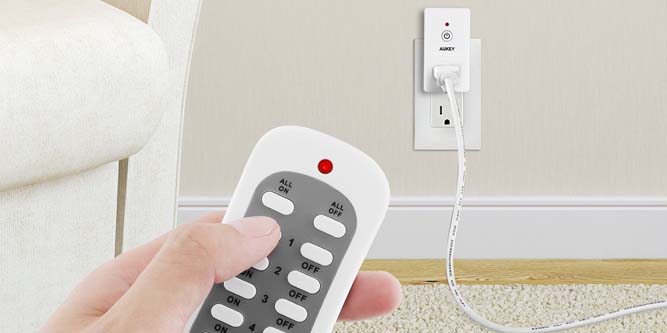
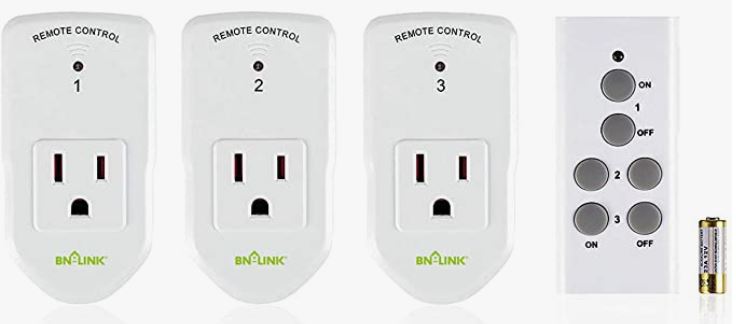
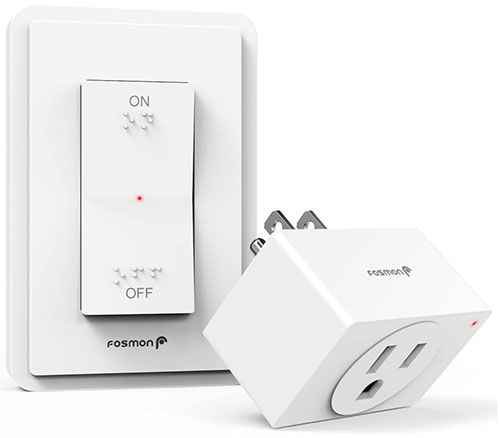
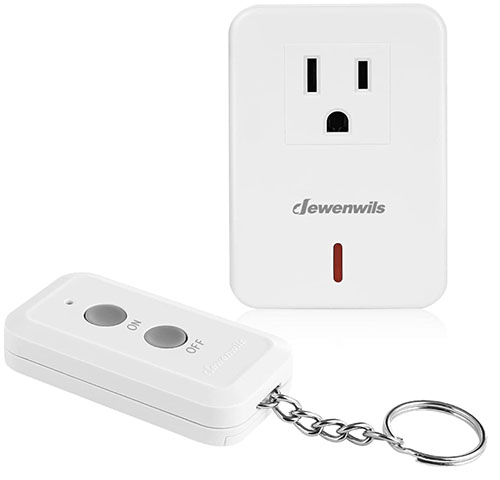
A very informative article. But I do have one question: Does anyone make a model that can control (say) 10 separate switches ??
I have the Aukey Remote Control Switch with 5 switches and it is great but I need more individual switches as I need most of them in the same room — I use them with my home theatre, which has a lot of devices but most of them can be turned off until I need them .
A second question: if one used several sets of these devices (each from a different manufacturer) would they interfere with each other ??